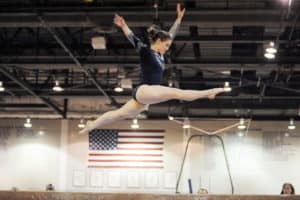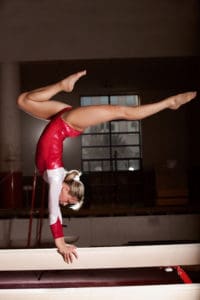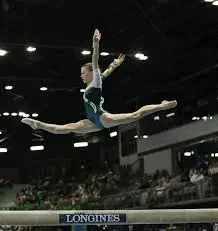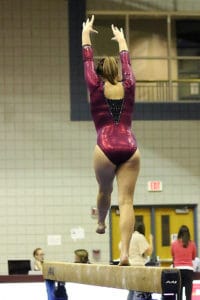This article has been updated to reflect the 2022-2026 DP Code of Points changes.
Introduction to Level 6 Beam
The Level 6 beam routines can be very quick, but they can also be a challenge! These routines combine basic acro skills, which can include flight skills or a series, along with dance skills such as leaps, jumps, and turns. What exactly is required in a Level 6 beam routine? Let’s take a look.
Philosophy Behind Level 6
The idea behind Level 6 and 7 gymnastics is to ease gymnasts into the optional levels, without the need to perform difficulty beyond the level’s requirements. For this reason, there are no composition deductions in these two levels. Composition deductions are deductions taken at the end of the routine, based on the construction of the routine. They can include deductions for lack of difficulty, too many similar skills, or failure to include certain skills in the routine.
In Level 6 and 7, these deductions are NOT applied. The goal is to create routines that meet the requirements and are performed as cleanly as possible. Often, the highest scoring routines are those that include the bare minimum number of skills, performed very well. There are general deductions that are taken at the end of the routine, such as rhythm and dynamics, and these deductions are still applied. But there’s no need to worry about exceeding the difficulty requirements. Just do what you can do well, and be done!
Value Parts for a Level 6 Beam Routine

Level 6 gymnasts need 5 A skills and 1 B skill on each event (bars, beam, and floor). All skills in gymnastics are evaluated based on their difficulty level, and they are given a value from A through E. A skills are the easiest, while B skills are a bit more difficult. The gymnast is allowed to choose the skills that she can perform the best in each of these difficulty categories. Each A skill is worth 0.10, and each B skill is worth 0.30. Deductions are taken off the Start Value if a skill is missing.
In Level 6 beam, gymnasts are only allowed to perform A and B skills, along with ONE C dance skill. Performance of additional C’s, acro C’s, or D/E skills will result in a 0.50 deduction from the Start Value for a restricted element.
Examples of B skills on beam include:
- Roundoff
- Back handspring
- Dive cartwheel
- Split jump (facing the end of the beam)
- Split leap
- Straddle jump (facing the end of the beam)
It’s important to note that some common mounts have no value. If you’re counting on the mount for a Value Part, make sure it’s listed in the Code of Points, or you’ll be missing a skill.
Special Requirements for a Level 6 Beam Routine
There are four Special Requirements for a Level 6 beam routine. Each Special Requirement is worth 0.50 off the Start Value.
The Special Requirements are as follows:
- Non-flight acro series OR one acro flight element
- One leap/jump with 180° cross or side split
- Min. 360° turn on one foot (Group 3 in the DP Code)
- “A” aerial/salto dismount
Here is more detail on each of these Special Requirements.
Non-flight acro series OR acro flight element

There are two options to fulfill the acro Special Requirement: a non-flight acro series or an acro flight element. It’s also allowable to perform an acro series with flight, although it’s not necessary. No extra points are given for exceeding the requirements.
Non-Flight Acro Series
In the non-flight series, at least one element must achieve or pass through a vertical handstand position. The skills in the acro series must start and finish on the beam.
Examples of non-flight acro series that meet this requirement are:
- Back walkover, back walkover
- Handstand (hold 2 seconds), back walkover
- Front walkover, front walkover
- Cartwheel, swing through, cartwheel
- Front walkover, cartwheel
- Back walkover, swing through, cartwheel (gymnast would need to switch legs)
Acro Series Connections
To get credit for a non-flight acro series, the two elements must be directly connected. The series is considered broken if any of the following occur:
- Stop between elements (body completely stops moving for any length of time)
- Loss of balance
- Movement/repositioning of foot/feet or pivoting
- Extra step, hop, or jump between elements
- Legs fully straighten and plie again to initiate the next element
- Kick or leg swing above 45 degrees leading into the next element
- Any deviation of body movement which is NOT in line with the beam
The kick above 45 degrees during a swing through series (such as cartwheel cartwheel) is a very common reason for a broken series. Movement of the feet between elements, as well as balance errors, are other common reasons a series may be broken.
It’s important to educate your gymnasts in what to do if they make a mistake during the first element of their series. For instance, let’s say a gymnast is supposed to perform a back walkover, back walkover series. She gets her feet onto the beam on the first back walkover, but falls. If she repeats the series, she will have performed three back walkovers, but she can only get credit for two. The third one gets 0 VP, and the gymnast would lose the Special Requirement.
A better option would be for the gymnast to have a backup series. Have her practice a handstand back walkover, or a tic-toc, back walkover, that she could perform in case she needs it.
For more information on beam series and connections, check out Is This Beam Series Connected?
Acro Flight Element
The acro flight element can be fulfilled by any A or B flight element that starts and finishes on the beam. It can be isolated or in a series. Here are some examples:
- Back handspring
- Roundoff
- Front handspring
- Dive cartwheel
The important thing here is that the skill must show flight from the feet to the hands, or from the hands to the feet. Front handsprings and dive cartwheels, in particular, must be performed with an obvious flight phase, or they will be downgraded, and Special Requirement credit will not be awarded. These two skills can be more difficult to get credit for, so use caution if you are depending on them for a Special Requirement.
Leap/jump with 180° cross/side split

To fulfill this requirement, the gymnast must perform either a leap or a jump with a 180° split. 180° is the expectation, but Special Requirement credit is given for a leap/jump with at least 135° split. The requirement can be met by either a leap off one foot, or a jump off two feet. The leap or jump can face the end of the beam or the side of the beam (but it cannot be higher than B value for Level 6).
Common skills that meet this requirement are:
- Split leap
- Split jump
- Sissonne
- Straddle jump
If a stag leap is performed, the front leg must fully extend in order to receive Special Requirement credit. If the front leg finishes in the stag position, the leap will not count for the Special Requirement.
360° turn on one foot
This requirement is pretty self explanatory. The gymnast must perform at least a full turn on one foot. Skills that meet this requirement will be found in Group 3 in the DP Code of Points.
The leg position is optional. As long as the gymnast makes it past the ¾ mark, she will receive credit for the full turn. An up to 0.20 deduction can be applied if the turn is incomplete.
“A” aerial/salto dismount
The gymnast can perform any “A” or “B” aerial or salto dismount to get credit for this Special Requirement. The salto can be backward or forward, with or without a twist. Common salto dismounts are a front tuck, front pike, back tuck, and back layout. Common aerial dismounts are a barani or a front layout off one foot.
As long as the gymnast lands on her feet first, she will receive credit for her dismount. If she does not land on the soles of the feet first, she will not get Special Requirement credit. Depending on how much of the dismount she completes, she may also receive a 0.30 deduction off the Start Value for no dismount.
Common Deductions for a Level 6 Beam Routine

In Level 6, the emphasis is on performing basic skills with excellent technique, to prepare for the higher levels. The routines that meet the requirements, with the cleanest execution, are the ones that will finish on top. In addition, these gymnasts will be the best prepared to move into Level 7 and beyond. What do I mean by “clean execution”? A gymnast with clean execution has minimal form deductions.
Here are some of the most common deductions that can occur during a Level 6 beam routine. These deductions are assessed each time they occur.
Common deductions include:
- Foot form – 0.05
- Concentration pause – 0.10 (2 seconds), 0.20 (>2 seconds)
- Insufficient split when required – up to 0.20
- Legs not parallel to beam in split or straddle jumps/leaps – up to 0.20
- Insufficient height (dance skills or acro flight skills) – up to 0.20
- Incomplete turn/twist – up to 0.20
- Poor body position – up to 0.20
- Incorrect posture on landings of elements and dismount
- Leg separation – up to 0.20
- Bent arms – up to 0.30
- Bent knees – up to 0.30
- Balance errors – up to 0.30 each
- Grasp of beam to avoid a fall – 0.30
- Fall – 0.50
General Deductions in a Level 6 Beam Routine
In a Level 6 beam routine, there are several categories of “general deductions”, which are evaluated by looking at the routine as a whole. These deductions are:
- Sureness – up to 0.20
- Rhythm – up to 0.20
- Dynamics – up to 0.20
- Footwork – up to 0.30
- Posture/alignment – up to 0.30
- Artistry – up to 0.30 (3 categories of artistry)
For more information on general deductions, see 6 General Deductions You’re Probably Getting.
Final Thoughts
The best Level 6 beam routines use skills that showcase the gymnast’s abilities. For instance, if the gymnast has poor flexibility, she might opt to perform only the minimum elements that require a full split, and use other skills to fulfill the rest of the requirements. The top Level 6 beam routines will also show great rhythm, artistry, and footwork. The gymnast should make all of her skills look easy, and NOT give the impression that she’s terrified of being on the beam! The judges love to see gymnasts’ confidence and personality during their beam routines, so keep working to show it off!
Further Reading
Tips and Resources for Level 6/7 Vault
Level 6 Bar Routine Recommendations
Level 6 Floor Routine Requirements
Making Sense of Composition: Level 8 Beam
Making Sense of Composition: Level 9 Beam
Making Sense of Composition: Level 10 Beam
References
USA Gymnastics J.O. Code of Points, 2022-2026.
